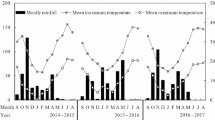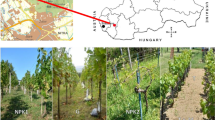Abstract
Root observations were carried out on a typic Paleudult in the humid forest zone of south eastern Nigeria in an alley cropping trial usingDactyladenia (Acioa) barteri andSenna (Cassia) siamea as hedgerow trees and the interrow space planted to maize/cassava intercrop. Rooting depth ofD. barteri andS. siamea exceeded 1.6 m. Lateral root propagation ofS. siamea was 15 m, and ofD. barteri was 5 m from the hedgerows. The whole no-tree control plot was within the range of roots of the adjacent hedgerows. Rooting density and depth ofS. siamea in the no-tree control plot was generally higher than of cassava.S. siamea and cassava root density were inversely correlated. Assuming radial symmetry of root propagation, water and nutrients were available from an area 6.1 and 2.3 times larger than the allocated plot size ofS. siamea andD. barteri, respectively. Data obtained in alley cropping trials, not considering lateral root propagation, can be invalidated through exploitation of the no-tree control treatment and nutrient acquisition by hedgerow species from a larger area than allocated, thus underestimating and overestimating the performances of the respective treatments. Possible alternative measures for avoiding root interference are discussed but no good solution can be given.
Similar content being viewed by others
References
Böhm W (1979) Methods of Studying Root Systems. Ecological Studies, 33. Springer Verlag, Heidelberg
Gichuru M and Kang BT (1990) Potential Woody species for alley cropping on acid soils. In: Moore E, ed, Agroforestry Land-Use Systems. Proceedings of a Special Session of American Society of Agronomy Annual Meeting, Anaheim, California, USA, Nov 28–29, 1988
Hairiah K, and Van Noordwijk M (1986) Root studies on a tropical ultisol in relation to nitrogen management. Rapport 7-86. Instituut voor Bodemvruchtbaarheid, Haren (Gr.), the Netherlands
IITA (1990) Annual Report for 1989 Resource and Crop Management Program, pp. 17–18 International Institute of Tropical Agriculture, Ibadan, Nigeria
Jonsson K, Fidjeland L, Maghembe JA, and Högberg P (1988) The vertical distribution of five roots of five tree species and maize in Morogoro, Tanzania. Agroforestry Systems 6: 63–69
Kang BT, Reynolds L and Atta-Krah AN (1990) Alley farming. Adv Agron 43: 315–359
Lal R (1989) Potential of agroforestry as a sustainable alternative to shifting cultivation: Concluding remarks. Agroforestry Systems 8: 239–242
Lal R (1991) Myths and scientific realities of agroforestry as a strategy for sustainable management for soils in the tropics. Adv Soil Sci 15: 91–137
Rao MR and Roger JH (1990) Discovering the hard facts. Part two: agronomic considerations. Agroforestry Today 2(2): 11–15
Rao MR, Kamara CS, Kwesiga F and Duguma B (1990) Methodological issues for research on improved fallows. Agroforestry Today 2(4): 8–12
Roger JH and Rao MR (1990) Discovering the hard facts. Part one: statistical considerations. Agroforestry Today 2(1): 4–7
Scherr SJ and Müller EU (1989) What happens in agroforestry development projects? Agroforestry Today 1(4): 8–13
Singh RP, Ong CK and Saharan N (1989) Above and below ground interactions in alleycropping in semi-arid India. Agroforestry Systems 9: 259–274
Szott LT (1987) Improving the productivity of shifting cultivation in the Amazon Basin of Peru through the use of leguminous vegetation. PhD dissertation, NC State University, Raleigh, NC, 168 pp
Tropsoils/NCSU (1987) Technical Report for 1986/87. North Carolina State University Raleigh, NC
Author information
Authors and Affiliations
Rights and permissions
About this article
Cite this article
Hauser, S. Root distribution ofDactyladenia (Acioa) barteri andSenna (Cassia) siamea in alley cropping on Ultisol. I. Implication for field experimentation. Agroforest Syst 24, 111–121 (1993). https://doi.org/10.1007/BF00706886
Issue Date:
DOI: https://doi.org/10.1007/BF00706886




